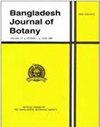Effects of different tillage management on the growth and yield of maize (Zea mays l.)
IF 0.3
4区 生物学
Q4 PLANT SCIENCES
引用次数: 0
Abstract
Effects of different tillage management on the growth and yield of maize were studied from early June to September 2017. The experiment was set up with three tillage treatments: traditional shallow moldboard plow tillage with straw removal (MT), sub-soiling/ plow tillage /sub-soiling rotation with straw mulch (ST) and no-till/sub-soiling/no-till rotation with straw retention (NT). The soil compaction of different soil layers, plant height, chlorophyll content, above-ground biomass and yield were determined through the three tillage practices. Results showed that NT and ST treatments helped to reduce soil compaction, and had a positive effect on maize root growth and development, plant height and chlorophyll content compared to the MT treatment. The chlorophyll value in early growth period under NT and ST increased by 31.8 and 24.6%, respectively, and the plant height was increased by 20.2 and 15.9% compared with MT, respectively. The size order of soil compaction was MT > NT > ST, and the soil compaction value was the maximum at 20 cm under MT treatment, which was 1007 kPa. Meanwhile, NT and ST also increased the plant above-ground biomass and yield of maize. Compared to MT treatment, the dry weight of plants for the NT and ST treatments significantly increased by 24.3 and 15.7%, respectively, and the grain yield significantly increased by 11.9 and 14.9%, respectively (P < 0.05). NT and ST tillage treatments are effective measures to improve structure of soil, contribute to plant growth and development and thereby increase in yield. Bangladesh J. Bot. 52(2): 451-458, 2023 (June) Special不同耕作方式对玉米生长和产量的影响
2017年6月初至9月,研究了不同耕作管理对玉米生长和产量的影响。本试验采用三种耕作处理:传统的浅犁板犁除秸秆耕作(MT)、底土/犁耕/底土覆盖轮作(ST)和免耕/底土/免耕留茬轮作(NT)。通过三种耕作方法测定了不同土层的土壤压实度、株高、叶绿素含量、地上生物量和产量。结果表明,与MT处理相比,NT和ST处理有助于降低土壤压实度,对玉米根系生长发育、株高和叶绿素含量有积极影响。与MT相比,NT和ST处理的生长前期叶绿素值分别提高了31.8%和24.6%,株高分别提高了20.2%和15.9%。土壤压实度的大小顺序为MT>NT>ST,在MT处理下,土壤压实值在20cm处最大,为1007kPa。同时,NT和ST也提高了玉米的地上生物量和产量。与MT处理相比,NT和ST处理的植株干重分别显著增加24.3%和15.7%,粮食产量分别显著增加11.9%和14.9%(P<0.05)。Bangladesh J.Bot.52(2):451-4582023(6月)特刊
本文章由计算机程序翻译,如有差异,请以英文原文为准。
求助全文
约1分钟内获得全文
求助全文
来源期刊

Bangladesh Journal of Botany
生物-植物科学
CiteScore
0.80
自引率
0.00%
发文量
77
审稿时长
9 months
期刊介绍:
Bangladesh in situated on the north of Bay of Bengal. Climatically it is a humid subtropical country. Most of the land is deltaic plain of two great rivers, the Ganges and the Bhrammaputra and it tributaries. The country has rich diversity of plants. Main crops cultivated are Rice, Jute, Wheat, Maize, Sugarcane, Mustard and different kinds of Lentils. There are a good number of Public and Private Universities and Plant Research Establishments.
Bangladesh Journal of Botany is the official organ of the Bangladesh Botanical Society established in 1972. Since 1972 Bangladesh Journal of Botany is being published regularly. Two issues of the Journal are published, one in June and another in December.
Scientific papers (Full paper and short communication) on any field of Plant Sciences from anywhere in the World are considered for publication in Bangladesh Journal of Botany.
 求助内容:
求助内容: 应助结果提醒方式:
应助结果提醒方式:


